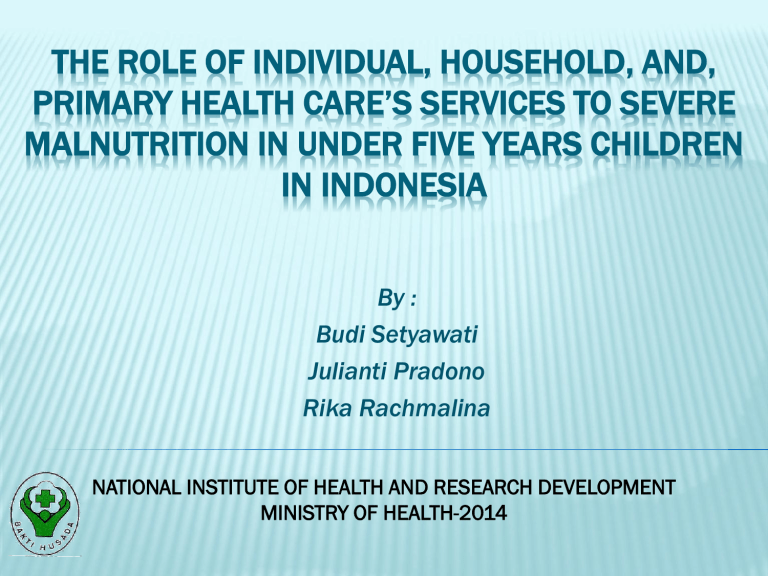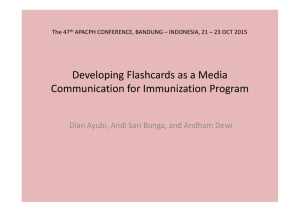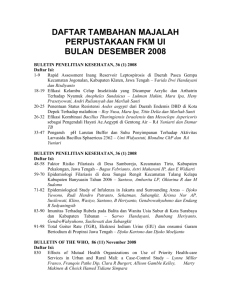the role of individual, household and health services at primary

THE ROLE OF INDIVIDUAL, HOUSEHOLD, AND,
PRIMARY HEALTH CARE’S SERVICES TO SEVERE
MALNUTRITION IN UNDER FIVE YEARS CHILDREN
IN INDONESIA
By :
Budi Setyawati
Julianti Pradono
Rika Rachmalina
NATIONAL INSTITUTE OF HEALTH AND RESEARCH DEVELOPMENT
MINISTRY OF HEALTH-2014
BACKGROUND
The first five years of live times is very important,
there is ‘Period window of opportunity’ in first two years very critical period for brain, physical and mental development in children.
Failure of growth in this period is adverse and irreversible (Unicef, 1998).
Impaired growth in children will decrease their intelligency (Licari et al, 2005)
Severe malnourished children is more likely to die than those who are not (Pelletier, 2003).
METHOD
Desain: a cross-sectional study
Data : National Basic Health Research (Riskesdas
2010) & Health Facilities Research (Rifaskes
2011).
Sampel :
Under five years old children (0-59 mo).
The family of those under five years old children.
Primary health care.
Dependent variable : nutritional status of children under five years.
METHOD
Independent variables:
Individual level (4) : infection, energy-protein consumption, weighing, immunization;
Family level(7) : mother’s education; mother’s parity; drinking water quality; facilities of defecation; liquid waste disposal; household waste handling ; Family’s economic status
Primary health care of sub-district level (7) : services; training; reporting; Ratio of physicians and population; midwives and population; TPG and population; Region with DTPK status (Daerah tertinggal, perbatasan kepulauan; remote area, borderline or islands).
Variables Operational Definitions Indicators
Individual level (children under five years old)
Severe malnutrition
History of children’s illnesses
Based on Z-Score of weight for age value
Severe malnutrition is Z-Score < -3
(WHO, 2005)
History of being suffered from malaria or other illnesses within first 6-48 hours of birth or in the first 28 days of birth
Immunization
Status
Having complete immunization according to children’s age. (Tuberculosis, Dipthery-Pertussis,
Measles, Polio, Tetanus, Hepatitis B).
Energy-protein
Intake
Routine weighing the children
The adequacy of energy-protein intake according to RDA (AKG WKNPG, 2004).
Weighing the children in consecutive months for the last 6 month (according to age) .
0 : Z-score ≥ -3
1 : Z-score < -3
0 : never been ilness
1 : had the illness
0 : Complete
Immunization
1: Incomplete
Immunization
0 : adequate energy
protein intake
1: inadequate energy
protein consumption
0 : weighing in
consecutive months
1: not weighing in consecutive
moths
Variables Operational Definitions Indicators
Household level
Mother’s education
Parity mother's formal education
The number of children had been born
0 : ≥ SMP (junior high school)
1 : < SMP
0 : children < 3
1 : children ≥ 3
0 :enough( ≥ quintil 2)
1 : less (< quintil 2)
Family economic status
Total living cost expenditure, using quintil 2. (Rp.
1,085,523)
The quality of drinking water composite variables of drinking water quality
(colorless, tasteless, and odorless). the distance between the source of drinking water to septic tank/stool (> 10 m) is also considered, when the water source is from wells/ pumps /springs / reservoirs /
0 : good quality
1 : not good quality
Variabel Definisi Operasional Indikator
Fesses disposal facilities
Composites of toilet type and fesses disposal.
Good : type of toilet is swan neck and landfills septic tank/SPAL.
Not good : the toilet plengsengan/pit/cubluk/no or a final disposal of excreta: pool/field/river/sea lake/ holes in the ground /beach/field/garden.
0 : good
1 : not good
Household liquid waste disposal
Household waste handling
Good: bathrooms/washrooms and kitchen waste is discarded into the SPAL or covered disposal in the yard.
Not good:
Waste is discarded into opened disposal in the yard/outside yard/ shelters (ground)/ into the gutter/river.
Good: garbage is discard into trailer trash/landfilled in the house yard/ composting
Not good: garbage is burned/dumped into the river stream
/ditches/sea or carelessly discarded.
0 : good
1 : not good
0 : good
1 : not good
Variabel Definisi Operasional Indikator
Primary health care at sub-distric level
Training Training of growth monitoring and management of malnutrition.
Good: The primary health centre provide training.
Composite from variables : service of weighing children’s Health services body, giving PMT recovery (recovery supplementary feeding), prevention of diarrhea, and immunization outside /inside the building.
Writing report Monthly reporting (nutrition, MCH and immunization) and nutritional surveillance reporting.
The ratio of doctors and population
The number of doctors in Primary health care (PHC) per population. Ideal: ≥ 40 physicians / 100,000 population.
The ration of midwifes and population
The number of midwifes in Primary health care (PHC) per population. Ideal: ≥ 100 bidan /100.000 penduduk
0 : good
1 : not good
0 : good
1 : not good
0 : good
1 : not good
0 : ideal
1 : not ideal
0 : ideal
1 :not ideal
The ratio of
TPG and pop
The number of in Primary health care (PHC) per population. Ideal: ≥ 22 TPG /100.000 penduduk.
(TPG=nutritionists)
0 : ideal
1 : not ideal
DTPK status DTPK is remote area, in the borderline or islands. 0 : non DTPK
1 : DTPK
METHOD
Data management:
Cleaning the data
Composite the data (grouping some certain data)
Data analysis:
Data is analysed using logistic regression to obtain candidate variables that influence severe malnutrition. Further analysis is using modeling multilevel logistic regression using Stata program
RESULTS
Overall samples that were analyzed: 7613 children under five years old living in 7032 families and in 1887 sub-districts in Indonesia.
Nutritional status of under five children
5.60%
84.40%
Severe malnutrition not severe malnutrition
RESULT
Individual sample characteristic
100
90
80
70
60
50
40
94.4
30
20
10
0
5.6
Tidak buruk
Status Gizi
Buruk
14.1
85.9
35.7
64.3
Cukup Kurang
Kons. Energi – Protein
Rutin ditimbang Tidak rutin ditimbang
Penimbangan
53.3
46.7
83.7
16.3
Imunisasi lengkap
Imunisasi tidak
Imunisasi lengkap
Sehat Pernah sakit
Status sakit
RESULT
Household sample characteristic
RESULT
THE RESULTS OF MULTIVARIATE ANALYSIS ON SEVERE MALNOURISHED
UNDER FIVE YEARS OLD CHILDREN IN INDONESIA
Variables
Individual level
Weighing children
Energy-protein intake
Immunization status
Household level
Mother’s education
Mother’s parity
Household waste handling
OR
1,28
1,41
1,33
1,61
1,33
1,59
Primary health care at sub-distric level
Reporting 1,33
95% CI
1,026 – 1,607
1,001 – 1,991
1,078 – 1,645
1,302 – 1,996
1,088 – 1,629
1,210 – 2,078
1,087 – 1,624 p
0,029*
0,049*
0,008*
0,005*
0,01*
0,05*
0,05*
FINAL MODEL OF MULTILEVEL LOGISTIC REGRESSION ANALYSIS OF SEVERE MALNOURISHED
CHILDREN UNDER FIVE YEARS 0LD IN INDONESIA
Model1
(null)
Model 2
(Individual)
Model 3
(household)
Model 4
(PHC)
Individual level
Weighing the children: not routinely
Energi-protein intake : inadequate
Immunization status : incomplete
0,368
0,600
0,609
0,320
0,473
0,383
0,317
0,460
0,387
Household level
Mother’s education : < SMP
Mother’s parity: ≥ 3
Household waste handling: not good
Primary health care at sub-distric level
Reporting : not good
Random Efect (SE)
Varians level 2 (household)
Varians level 3 (primary health care)
3,340
1,234
2,971
0,914
0,520
0,360
0,699
3,096
0,673
0,503
0,364
0,696
0,427
2,975
0,641
ICC( INTERCLASS CORRELATION COEFFICIENT )
ICC
ICC level 1 (Individual)
ICC level 2 (Household)
ICC level 3 (Primary health care at sub-distric level)
Model
41,8%
42,5%
15,7%
From the calculation of the ICC is shown that the role of household level to severe malnutrition status of under five years old children in Indonesia, is the greatest (42.5%,) in household level, followed individual level (41.8%) and health services in sub-district Primary health care level (15.7%).
VALUE OF OR, MOR AND IOR FOR RISK SEVERE MALNUTRITION IN CHILDREN
Level 0 Level 1 Level 1,2 Level 1,2,3
Odds Ratio (OR)
Determinant of Individual level
Weighing the children: not consecutive month/not routinely
Energi-protein intake: inadequate
Immunization status : incomplete
Median Odds Ratio (MOR)
Household level
PHC at sub-distric level
Interval Odds Ratio (IOR)
Determinant of household level
Mother’s education : ≥ SMP
5,72
2,89
: <SMP
Mother’s parity : < 3
: ≥ 3
Household waste handling: good
: not good
Determinant of PHC at sub-distric level
Report writing: good
: not good
1,44
1,82
1,84
5,18
2,49
1,38
1,60
1,47
5,36
2,19
1,37
1,58
1,47
5,18
2,15
1 1
0,069-40,82 0,073-37,68
1 1
0,059-34,78 0,063-32,79
1
0,083-48,82
1
0,088-45,70
1
0,36-6,54
RESULT
Peran var tk Individu terhadap gizi buruk
Tk RT : PCV (3,340-2,971)/3,340 x 100% = 11,04%
var tk indiv (penimbangan, konsumsi energiprotein dan imunisasi) menerangkan 11,04% variasi gizi buruk pada tk RT.
Tk Kec : PVC : (1,234-0,914)/1,234 x 100% =
25,93% var tk indiv (penimbangan, konsumsi energi-protein dan imunisasi) menerangkan
25,93%. variasi yang terjadi di tingkat kecamatan.
OR Penimbangan ; 1,37 ; OR kons energi-prot :
1,58; OR imunisasi : 1,47
RESULT
Peran var RT thd gizi buruk
Tk RT :2,971 3,096 var RT ≠ berperan pd variasi gizi buruk di tk RT
Tk yankes : PVC : (0,914-0,673)/0,971 x 100% = 26,37% . peran var
RT (pendidikan ibu, jumlah anak dan penanganan sampah) dapat menerangkan 26,37% variasi di tk yankes
MOR : 5,36 balita di RT (≠ rutin ditimbang, konsumsi energiprotein < kecukupan, imunisasi ≠ lengkap, ibu ≠ tamat SMP, jumlah anak ≥ 3 orang, dan penanganan sampah kurang baik) berpeluang gizi buruk 5,36 kali. Nilai MOR > 1 menunjukkan bahwa terdapat variasi kejadian gizi buruk antar rumahtangga
IOR lebar variasi gizi buruk antar rumahtangga besar. Nilai IOR pd var RT mencakup angka satu variasi gizi buruk antar RT > pengaruh variabel kontekstual TK RT (pendidikan ibu, jumlah anak dan penanganan sampah) terhadap kejadian gizi buruk.
RESULT
Peran var Tk Yankes kecamatan
Peranan var tk yankes dapat menerangkan terjadinya variasi yang terjadi pada tk RT(3,9%) dan kecamatan (4,75%).
MOR : 2,5 balita yang tinggal di kecamatan berisiko
(balita yang penimbangannya ≠ rutin, konsumsi energi-protein < kecukupan, imunisasi ≠ lengkap, jumlah anak ≥ 3 orang, penanganan sampah <baik dan pembuatan laporan <baik) berpeluang 2,5 kali mengalami gizi buruk dibandingkan responden yang tinggal di kecamatan yang kurang berisiko terhadap kejadian gizi buruk. MOR > 1 : terdapat variasi kejadian gizi buruk antar kecamatan.
CONCLUSION
Severe malnutrition in under five children is a combination of compositional factors (individual) and contextual factors
(household and PHC at sub-district).
The largest role is in household level (42.5%), followed by individual level 41.8%, and PHC at sub-district level
(15.7%).
Children have a risk of having severe malnutrition when having inadequate protein-energy intake (OR: 1.58), incomplete immunizations (OR: 1.47) and being weighed not routinely (OR: 1.37).
Household have a risk of having children suffering from malnutrition 5.36 times, when having inadequate proteinenergy intake, incomplete immunizations, and being weighed not routine, mother’s formal education is junior high school, having ≥ 3 children, and have unwell household waste handling.
CONCLUSION
Children who live in sub-district PHC which having inadequate protein-energy intake, incomplete immunizations, and being weighed not routine, mother’s formal education is junior high school, having ≥ 3 children, have unwell household waste handling and writing report is not good category have 2.5 times suffering from severe malnutrition.
SUGGESTION
to prevent malnutrition in children under five years old, an effort of well-preventive and promotive should be done, mainly in health promotion programs for mother, such as knowledge of parenting (consumption, immunizations and monitoring children’s weight) as well as household and environmental sanitation.
For health care personel in primary health care, it is important to do a valid report as for early detection of severe malnutrition and follow-up of the result of that report

